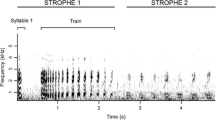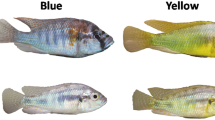Summary
A prominent dark facial stripe, the ‘eyebar’, is an important component of the reproductive coloration and dominance displays of ‘barred’ territorial maleHaplochromis burtoni (Teleostei; Cichlidae). “Barless” territorial males are identical to barred, behaviorally and morphologically, except they completely lack an eyebar during agonistic encounters with conspecifics.
Both anatomical and physiological differences characterize eyebar pigment cells of barred and barless males. Melanophores and iridophores, which form a single structural and functional unit in the eyebar, contain less pigment in barless males. Physiologically, eyebar melanophores are tonically expanded in barred males, contracted in barless males. This physiological difference is correlated with a difference in the alpha adrenoceptor-mediated aggregation response of the cells in vitro: eyebar melanophores of barless males are significantly more responsive to physiological concentrations of the sympathetic neurotransmitter norepinephrine than those of barred males, and this intermorph difference appears to be unique to the eyebar color pattern.
Physiological and morphological characteristics of eyebar pigment cells are functionally related. When barless males first begin to use the eyebar as a social display, the physiological state of melanophores changes from aggregation to dispersion. In subsequent weeks, additional pigment develops, which enhances conspicuousness of the display.
Similar content being viewed by others
Abbreviations
- M.I. :
-
melanophore index
- NE :
-
norepinephrine
References
Abbot FS (1968) The effects of certain drugs and biogenic substances on the melanophores ofFundulus. Can J Zool 46:1149–1157
Alexander NJ, Fahrenbach WH (1969) The dermal chromatophores ofAnolis carolinensis (Reptilia, Iguanidae). Am J Anat 126:41–56
Bagnara JT, Hadley ME (1973) Chromatophores and color change. Prentice Hall, Englewood Cliffs N.J.
Bagnara JT, Taylor JD, Hadley ME (1968) The dermal chromatophore unit. J Cell Biol 38:67–79
Bauer DH, Demski LS (1980) Vertical banding evoked by electrical stimulation of the brain in anaesthetized green sunfishLepomis cyanellus and bluegills,Lepomis machrochirus. J Exp Biol 84:149–160
Cott HB (1957) Adaptive coloration in animals. Methuen, London
Demski LS, Knigge KM (1971) The telencephalon and hypothalamus of the bluegill: evoked feeding, aggressive and reproductive behavior with representative frontal sections. J Comp Neurol 143:1–16
Demski LS, Dulka JG, Hornby PK (1984) Sex-color changes evoked by brain stimulation in fishes. Soc Neurosci Abstr 10:404
Elashoff JD (1981) Down with multiplet-tests. Gastroenterology 80:615–620
Fernald RD (1976) The effect of testosterone on the behavior and coloration of adult male cichlid fish (Haplochromis burtoni Gunther). Horm Res 7:172–178
Fernald RD (1977) Quantitative observations ofHaplochromis burtoni under semi-natural conditions. Anim Behav 25:643–653
Fernald RD (1981) Chromatic organization of a cichlid fish retina. Vision Res 21:1749–1753
Fries EFB (1958) Iridescent white reflecting chromatophores (antaugophores, iridoleucophores) in certain teleost fishes, particularly inBathygobius. J Morphol 103:203–254
Fujii R (1961) Demonstration of the adrenergic nature of transmission at the junction between melanophore-concentrating nerve and melanophore in bony fish. J Fac Sci Univ Tokyo, Section IV 9:171–196
Fujii R, Novales R (1969) The nervous mechanism controlling pigment aggregation inFundulus melanophores. Comp Biochem Physiol 29:109–124
Fujii R, Miyashita Y (1975) Receptor mechanisms in fish chromatophores. I. Alpha nature of adrenoceptors mediating melanosome aggregation in guppy melanophores. Comp Biochem Physiol 51C:171–178
Fujii R, Miyashita Y (1976) Beta adrenoceptors, cyclic AMP and melanosome dispersion in guppy melanophores. In: Riley V (ed) Pigment cells, vol 3. Karger, Basel, pp 336–339
Gray EG (1956) Control of the melanophores of the minnow (Phoxinus phoxinus L.). J Exp Biol 33:448–459
Grove DJ (1969) Melanophore dispersion in the minnowPhoxinus phoxinus (L.). Comp Biochem Physiol 28:55–65
Hailman JP (1977) Optical signals. Fitzhenry and Whiteside, Don Mills, Ontario
Hawkes JW (1974) The structure of fish skin. II. The chromatophore unit. Cell Tissue Res 149:159–172
Healey EG (1951) The colour change of the minnowPhoxinus laevis AG. I. Effects of spinal section between vertebrae 5 and 12 on the responses of the melanophores. J Exp Biol 28:297–319
Heiligenberg W, Kramer U, Schulz V (1972) The angular orientation of the black eye-bar inHaplochromis burtoni (Cichlidae, Pisces) and its relevance to aggressivity. Z Vergl Physiol 76:168–176
Huffman BB, Lefkowitz RJ (1980) Radioligand binding studies of adrenergic receptors: new insights into molecular and physiological regulation. Annu Rev Pharmacol Toxicol 20:581–608
Hogben LT, Slome D (1931) The pigmentary effector system. VI. The dual character of endocrine coordination in amphibian colour change. Proc R Soc (Lond) B 108:10–53
Land MF (1972) The physics and biology of animal reflectors. Progr Biophys Molec Biol 24:75–106
Leong C-Y (1969) The quantitative effect of releasers on the attack readiness of the fishHaplochromis burtoni (Cichlidae: Pisces). Z Vergl Physiol 65:29–50
Miyashita Y, Fujii R (1980) Hormone effects and cyclic AMP in dissociated guppy melanophores — a brief note. J Lib Arts Sci Saporo Med Coll 21:65–68
Muske LE (1983) To bar or not to bar? Control of a social signal. PhD Diss., University of Oregon
Muske LE, Fernald RD (1987) Control of a teleost social signal. I. Neural basis for differential expression of a color pattern. J Comp Physiol A 160:89–97
Nickerson M, Hollenberg NK (1967) Blockade ofα-adrenergic receptors. In: Root WS, Huffman FG (eds) Physiological pharmacology, vol IV. The nervous system. Academic Press, New York, pp 243–305
Novales RR, Fujii R (1970) A melanin-dispersing effect of cyclic adenosine monophosphate onFundulus melanophores. J Cell Physiol 75:133–136
Odiorne JM (1957) Color changes. In: Brown ME (ed) The physiology of fishes, vol 2. Academic Press, New York, pp 387–401
Pickford GE, Atz JW (1957) The chromatophore hormones of the pituitary. In: The physiology of the pituitary gland of fishes. New York Zoological Society, New York, pp 32–59
Pye JD (1964) Nervous control of chromatophores in teleost fishes. I. Electrical stimulation in the minnowPhoxinus phoxinus (L.). J Exp Biol 41:525–534
Schliwa M, Bereiter-Hahn J (1974) Pigment movements in fish melanophores: morphological and physiological studies. IV. The effect of cyclic adenosine monophosphate on normal and vinblastine-treated melanophores. Cell Tissue Res 151:423–432
Skolnick P, Stalvey LP, Daly JW, Hoyler E, Davis JN (1978) Binding of alpha- and beta-adrenergic ligands to cerebral cortical membranes: effect of 6-hydroxydopamine treatment and relationship to the responsiveness of cyclic AMP-generating systems in two rat strains. Eur J Pharmacol 47:201–210
Smith DC (1931) The influence of humoral factors upon the melanophores of fishes, especiallyPhoxinus. Z Vergl Physiol 15:616–636
Sokol RR, Rohlf FJ (1981) Biometry. Freeman and Co., San Francisco
Waring H (1963) Color change mechanisms of cold-blooded vertebrates. Academic Press, New York
Author information
Authors and Affiliations
Rights and permissions
About this article
Cite this article
Muske, L.E., Fernald, R.D. Control of a teleost social signal. J. Comp. Physiol. 160, 99–107 (1987). https://doi.org/10.1007/BF00613445
Issue Date:
DOI: https://doi.org/10.1007/BF00613445




